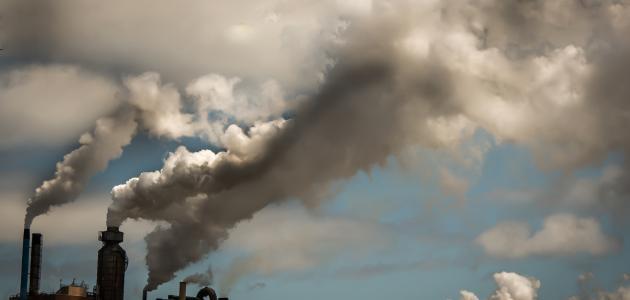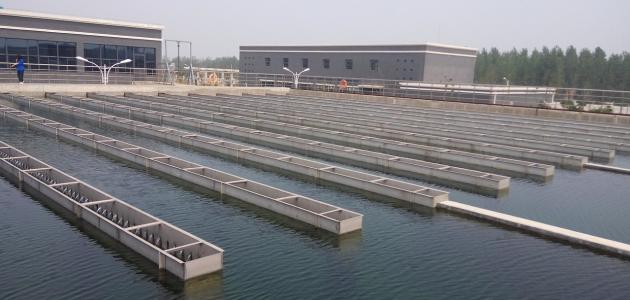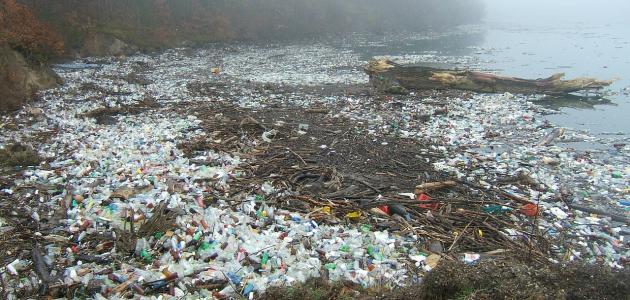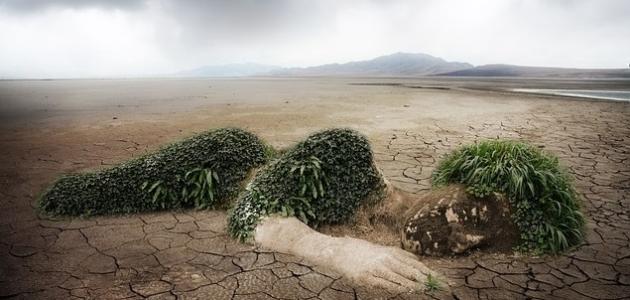The causes of soil pollution
Soil generally contains in its natural composition, whether polluted or not, a group of compounds - that can be considered pollutants - such as: minerals, inorganic ions, salts (such as phosphates, carbonates, sulfates, and nitrates), and organic compounds (such as lipids, proteins). , DNA, fatty acids, hydrocarbons, and alcohol), and the term soil pollution can be used when the percentage of these pollutants exceeds the normal and accepted percentage.
These compounds are formed in the soil by several factors, including: microbial activity in the soil, and the decomposition of living organisms such as animals and plants. The path of shallow groundwater flowing through the soil, and in general the sources of soil pollution are represented by two sources: the human source or the natural source.
Human causes of soil pollution
Chemicals resulting from human activities are the main source of soil pollution, and they may be used directly in industry, or they may be formed as a by-product from many sectors: such as industrial activities, livestock breeding, household waste, agricultural chemicals, and petroleum-derived products. These chemicals enter the soil either by chance through oil spills, or the leaching of some materials in landfills, or they may enter the soil in known ways, as is the case when using fertilizers and pesticides, or irrigation using untreated sewage, or through lands prepared for waste. Sewage water, and the following is an explanation of the most important human factors that have contributed and are still contributing significantly to soil pollution:
Read also:The school environment and its preservationindustry sector
The industrial sector is the largest sector that contains a variety of pollutants, each of which has a different effect on the environment according to its nature. To the soil through acid rain or regular rain, and pollutants can be transferred to the soil due to some wrong behaviors in the industrial sector, such as wrong chemical storage in agricultural lands, and direct disposal of its waste in these lands. It was considered safe at that time, but today it is considered one of the largest sources of pollution, and the problem of soil pollution here lies in the fact that the lands allocated for industrial sectors are large in area, which makes treating them a great and costly challenge.
Wrong behavior may also lead to a new type of pollution, namely thermal pollution, as some factories work to re-pump water and other liquids used to cool machines in thermal power plants to the seas, rivers, and other water sources, so that these liquids increase in addition to Thermal pollution from the concentration of heavy metals and chlorine in the water, which may eventually lead to the destruction of the life of aquatic organisms, and some other sources resulting from humans such as dust, waste, leakage of raw materials, fires, and fuel ashes may contribute to an increase in the percentage of heavy metals in the soil in some industrial sites.
Read also:Protect the forestAccording to European directives on pollution prevention and control, human activities that cause soil pollution in the industrial sector have been classified into 6 main categories:
- energy industries.
- Production and processing of ores.
- metal industry.
- Chemical industries and facilities.
- waste management sector.
- Other sectors, including: paper industry, textiles, leather tanning, intensive poultry farming facilities, carbon and graphite production, and others.
Soil pollution due to industrial activities has a number of harmful effects, the most important of which are:
- Hazardous chemicals reaching groundwater.
- disturbing the environmental balance.
- Release of a number of polluting gases.
- Release harmful radiations.
- Decreased plant production in agricultural lands.
- An increase in soil salinity or what is known as salinization, and it was observed that it affects lands near industrial facilities, especially those associated with chlor-alkali manufacturing, textile production, glass, rubber, leather tanning, metal manufacturing, medicine, oil and gas drilling, and the manufacture of Dyes, ceramics, soap and detergent production.
Mining sector
Since time immemorial, mining has had a great impact on soil, water, and plants. There are many documents that indicate the great damage caused by mining activities to the soil. Smelting minerals to separate them from each other led to the production of large quantities of heavy metals and toxic elements, and the problem lies in the fact that they remain for a long time in the environment even after the end of the activities that led to its production, as toxic substances consisting of fine particles containing certain concentrations of heavy metals may reach the agricultural soil due to erosion processes resulting from wind and water, for example, high and toxic concentrations were found of chromium and nickel in agricultural lands near one of the abandoned chromite and asbestos mining mines, which now pose a great threat to human life and livestock in that area.
Read also:Essay on factory smokeOn the other hand, these industries cause the spread of many radioactive materials, which makes them a real threat to the surrounding environmental systems. The manufacture of fertilizers, for example, depends mainly on mining phosphate rocks rich in radioactive materials, which produce a by-product called Phosphogypsum. ), and it is a substance that preserves about 80% of its original radioactive activity as a result of the decay of some radioactive elements in it, such as radon, and for another example, during the extraction of oil and gas - which are considered one of the most famous sources of pollution with a fixed source - leakage of oil slicks and brine solutions may result, and these contain The solutions contain high concentrations of salt, small percentages of some toxic elements, and some naturally occurring radioactive substances.
Agriculture sector
Modern agriculture involves the use of many new and technological methods to increase the agricultural yield, as the use of large quantities of fertilizers, pesticides, and herbicides contributes to significant soil pollution. Inorganic chemicals from soil erosion in turn increase soil pollution.
The following is a highlight of the most important agricultural methods that pollute the soil
Fertilisers
Fertilizers are one of the main factors for soil pollution. The manufacture of fertilizers is based on phosphate rock and fly ash that increase the percentage of heavy metals such as copper, zinc, lead, cadmium, and persistent, bio-accumulative, and toxic substances (in English: Persistent, Bio-accumulative, Toxic-chemicals) for short. (PBTs) in the soil. Animal and chemical fertilizers usually result in high levels of pollutants. Phosphate fertilizer contains a percentage of cadmium, which is mainly found in phosphate rock. Fertilizers contain high levels of copper and zinc.
pesticides
Pesticides of all kinds: insecticides, herbicides, and fungicides contribute to soil pollution. Pesticides that are applied to tree seeds and leaves will reach the soil, which leads to the accumulation of fertilizer deposits over time, which ultimately leads to water and soil pollution. , and food, and the chemicals in fertilizers are very harmful to human health, and on the other hand, these chemicals may accumulate in the bodies of herbivores to hinder their growth and cause what is known as bioaccumulation, and when carnivores feed on herbivores, This means an increase in the levels of pollutant accumulation in them, and this phenomenon is known as biomagnification, and it means an increase in the concentration of a non-degradable substance along the food chain.
Animal Production
Animal production is another source of soil pollution if animal waste is not properly managed and disposed of. Animal waste may contain parasites and residues of drugs that were given to them, which if they reach the soil will accumulate in it for several years. Many of the materials used In the animal pharmaceutical industry, lipolysis is not biodegradable, which makes it usable as a fertilizer, but this fertilizer will in turn affect many of the microorganisms and beneficial organisms present within the soil.
urban life
Waste generated from commercial and residential buildings is another source of soil pollution, and it usually includes: garbage, a number of plastic materials, glass, metal cans, fibers, paper, rubber, fuel waste, tree leaves, containers, abandoned cars, and other products. Although urban waste differs in its components from industrial waste, it still poses a real threat to the soil. Because it is not easily biodegradable, urban practices involve many things that cause soil pollution, the most important of which are:
- Human activities, which cause soil pollution directly and indirectly.
- Incorrect drainage methods, pollutant-laden runoff near land and streams.
- Incorrect methods of garbage disposal, which results in the decomposition of the components of the garbage inside the soil and the accumulation of chemicals and pollutants resulting therefrom. These pollutants may leak into the groundwater or into the water network used for domestic matters.
- Large accumulation of waste in the same area, which will increase the presence of bacteria in the soil, and the decomposition of waste in the presence of bacteria leads to the emission of methane gas, which contributes to the increase and development of the global warming phenomenon, and reduce the quality and quality of the surrounding air. Also, the accumulation of waste results in the release of unpleasant odors that may affect on organisms.
Transportation sector
Activities related to the transport and communications sector constitute one of the most important sources of soil pollution. This is due to the emissions from the combustion of fuel in vehicle engines, which reach the soil by deposition from the atmosphere and the leakage of gasoline from vehicles. The spray resulting from the movement of vehicles on wet roads during rain also contributes to the transfer of polycyclic aromatic hydrocarbons. ), rubber, and transportation of particles rich in heavy metals resulting from the corrosion of metal parts and tires, and this problem can be reduced by focusing on establishing a sewage network based on sound foundations.
The problem of soil pollution near streets and highways is a real and serious problem in urban and semi-urban areas. It has been observed that the soil that is located on the side of the road takes place in which several processes related to heavy metals occur, as these minerals are deposited on tree leaves, then absorbed, and transported to tissues. The pollutants are transferred from plants to animals, then to humans, which poses a threat to their health. Perhaps one of the biggest pollutants that the soil suffers from due to the transportation sector is lead resulting from leaded gasoline used in transportation.
Wastewater
Wastewater causes soil pollution as a result of the failure to control the disposal of sewage water and liquids resulting from domestic water uses, and the failure to control the disposal of industrial waste that includes a wide range of pollutants, agricultural waste resulting from animal husbandry, irrigation drainage and surface runoff water Irrigation with sewage water causes radical changes in the irrigated soil, including physical changes, such as: the ability of the soil to filter, the change of humus content in the soil, and porosity, in addition to many chemical changes, such as: the reactions that occur in the soil, the soil alkalinity, the salinity, And the quantity and abundance of elements and nutrients such as nitrogen, potash, and phosphorus. The soil may also be polluted due to sludge resulting from sewage treatment (in English: Sewage Sludge) through the accumulation of a number of metals such as lead, zinc, cadmium, and nickel in it, which may lead to poisoning of plants. .
Weapons and mine industry
The wars that took place during the twentieth century led to soil pollution in some way. Weapons were made from non-biodegradable materials and from chemicals capable of remaining in the soil for centuries after the end of the war. This is one of the most serious problems facing the soil today. The problem exists only in times of war, as currently there are vast areas of the current soil under the influence of military activities, such as lands prepared for firing tests, and the problem here lies in the fact that attempts to reclaim these lands take a long time, which may sometimes reach many centuries.
Each of the world wars left its effects on the soil, such as the presence of landmines, ammunition remnants, chemical residues, radioactive materials, and toxic biological agents, which left many lands unsuitable for any kind of investment, and there are many reports indicating the presence of many mines. Unexploded ordnance in many countries of the world, and some studies indicate that the soil during periods of war suffered from contamination during operations to get rid of ordnance due to the lack of controls on the production of weapons at that time.
Natural causes of soil pollution
Natural events are one of the sources of soil pollution, such as volcanic eruptions and forest fires, which release a number of toxic elements into the atmosphere such as dioxin-like compounds and polycyclic aromatic hydrocarbons. The soil accompanying any volcanic activity is rich in heavy metals, and may produce many polluting heavy metals. Because of the weathering processes of rocks, it can also be produced due to the minerals copper, chromium, and others, and these natural pollutants may not cause any significant environmental problems, due to the ability of plants to grow, regenerate, and adapt, but problems arise when environmental systems are subject to external pressure factors that affect their flexibility, And her ability to resist.
Heavy metals and radionuclides present in the soil may pose a threat to humanity and the environment if their natural proportions are exceeded in the soil. For example, arsenic (which is one of the heavy metals) is one of the dangerous pollutants on the soil. Mineral ores, as it is found naturally in the mineral Arsenopyrite or Arsenopyrite (in English: Arsenopyrite), and radioactive radon gas is found naturally in rocks and soil, and the structure and porosity of the soil control its spread from the deep layers to the surface layers, and it is worth noting that natural radioactive activities occur In acidic igneous rocks, but according to scientists' observations, carbonate-rich soils or sedimentary rocks emit more radon emissions than any type of soil or rock.









